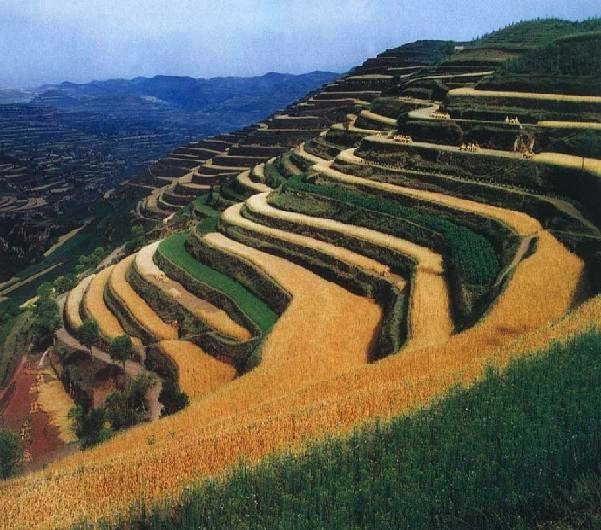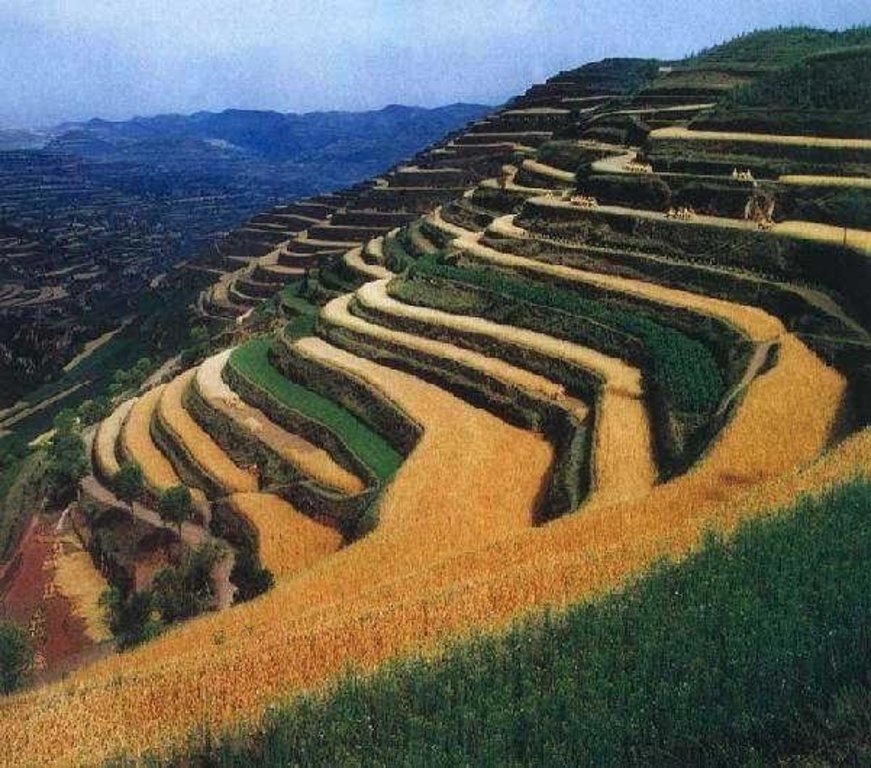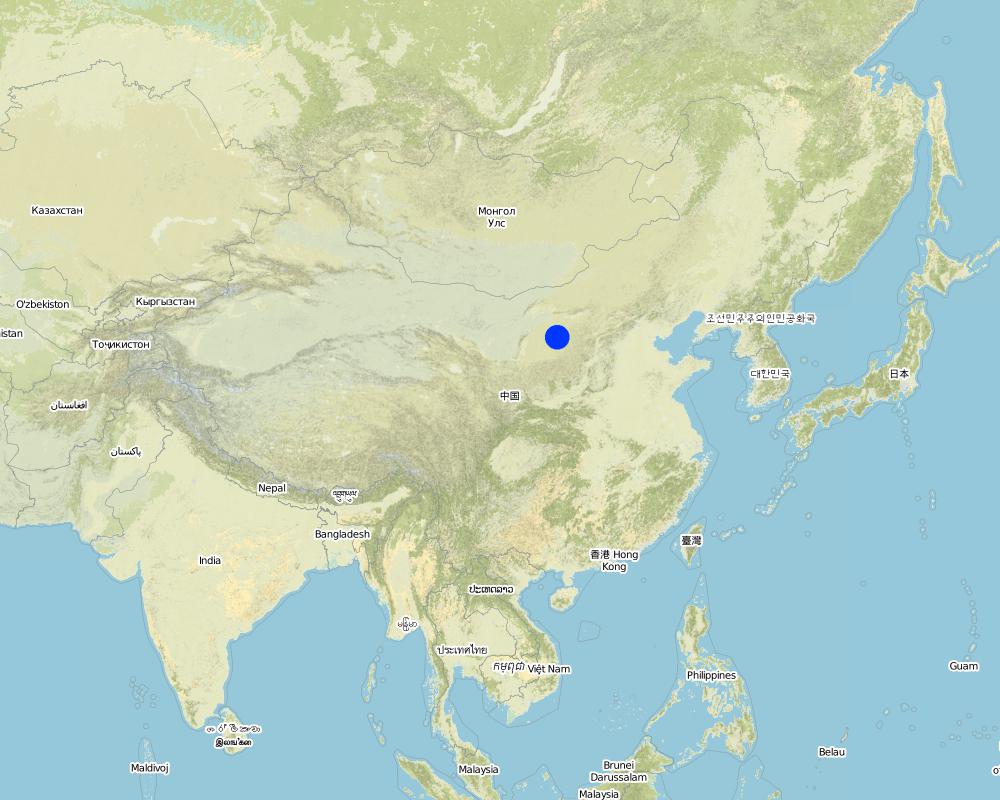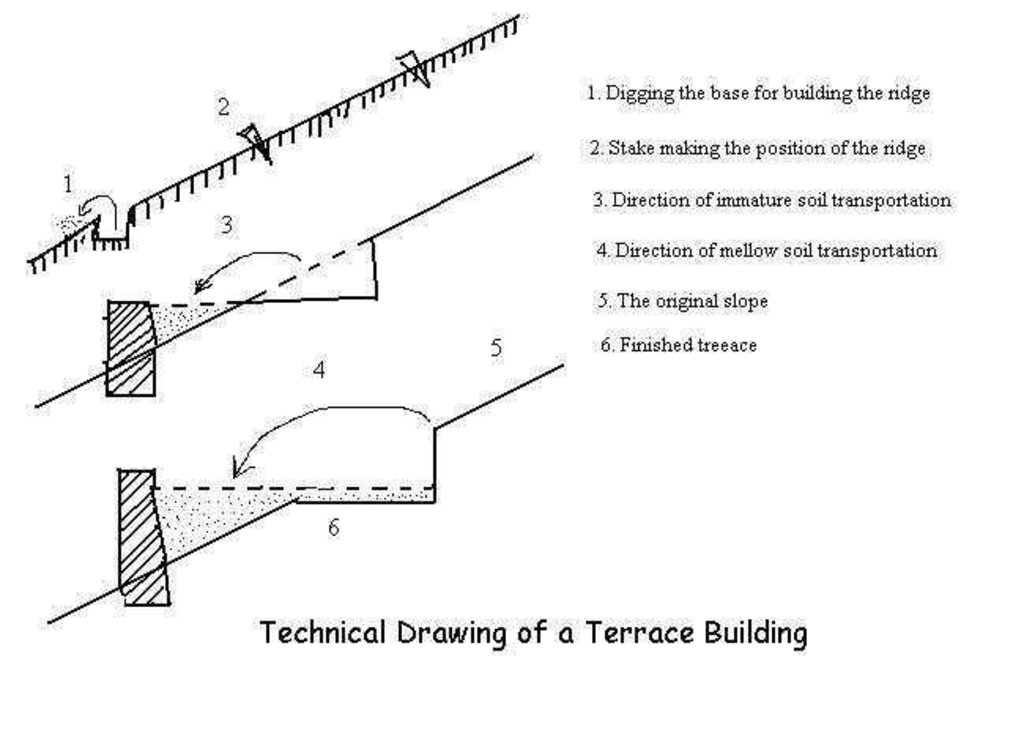Terrace [China]
- Creation:
- Update:
- Compiler: Meili WEN
- Editor: –
- Reviewers: David Streiff, Alexandra Gavilano
Terrace
technologies_1367 - China
View sections
Expand all Collapse all1. General information
1.2 Contact details of resource persons and institutions involved in the assessment and documentation of the Technology
Name of the institution(s) which facilitated the documentation/ evaluation of the Technology (if relevant)
Department of Resources and Environmental Science, Beijing Normal University (Department of Resources and Environmental Science, Beijing Normal University) - China1.3 Conditions regarding the use of data documented through WOCAT
The compiler and key resource person(s) accept the conditions regarding the use of data documented through WOCAT:
Yes
2. Description of the SLM Technology
2.1 Short description of the Technology
Definition of the Technology:
A terrace is a kind of measure to change the slope, which has a raised bank of earth or stone with vertical or sloping sides and a approximately flat top.
2.2 Detailed description of the Technology
Description:
A terrace has a raised bank of earth or stone with vertical or sloping sides and a approximately flat top. It can reduce slope angle and length, retain runoff, increase infiltration and reduce the soil loss. Crops can grow well because water increases in soils. Meanwhile, ground cover is improved. Terrace can be constructed by manual labor or machine. Firstly, determining the width of the field according to the slope angle and soil texture. Secondly, putting the topsoil aside. Thirdly, leveling up the slope and constructing banks. At last, putting the topsoil to the top of the flat surface.
2.3 Photos of the Technology
2.5 Country/ region/ locations where the Technology has been applied and which are covered by this assessment
Country:
China
Region/ State/ Province:
Shaanxi, Shanxi, Inner Mongolia, Henan, Gansu
Specify the spread of the Technology:
- evenly spread over an area
If the Technology is evenly spread over an area, specify area covered (in km2):
26666.7
If precise area is not known, indicate approximate area covered:
- > 10,000 km2
Comments:
Total area covered by the SLM Technology is 26666.7 km2.
Terrace is one of the most outstanding achievements in SWC in China. It can prevent soil and water loss so that slope land can be sustainable development. There are about 26.7 million ha of terrace in China, of which more than 13.3
Map
×2.6 Date of implementation
If precise year is not known, indicate approximate date:
- more than 50 years ago (traditional)
2.7 Introduction of the Technology
Specify how the Technology was introduced:
- as part of a traditional system (> 50 years)
Comments (type of project, etc.):
Summary from farmers' long term experience in SWC, later being innovated.
3. Classification of the SLM Technology
3.1 Main purpose(s) of the Technology
- reduce, prevent, restore land degradation
3.2 Current land use type(s) where the Technology is applied

Cropland
- Annual cropping
- Tree and shrub cropping
Annual cropping - Specify crops:
- cereals - maize
- legumes and pulses - peas
Number of growing seasons per year:
- 1
Specify:
Longest growing period in days: 160Longest growing period from month to month: May-Sep
Comments:
Major land use problems (compiler’s opinion): Soil and water lose seriously, soil degrades, soil fertility decreases and crop yield declines.
Major land use problems (land users’ perception): crop yield declines, weak ability of resisting drought
3.4 Water supply
Water supply for the land on which the Technology is applied:
- rainfed
Comments:
Water supply also mixed rainfed - irrigated
3.5 SLM group to which the Technology belongs
- cross-slope measure
3.6 SLM measures comprising the Technology

structural measures
- S1: Terraces
3.7 Main types of land degradation addressed by the Technology

soil erosion by water
- Wt: loss of topsoil/ surface erosion
Comments:
Main type of degradation addressed: Wt: loss of topsoil / surface erosion
3.8 Prevention, reduction, or restoration of land degradation
Specify the goal of the Technology with regard to land degradation:
- reduce land degradation
4. Technical specifications, implementation activities, inputs, and costs
4.1 Technical drawing of the Technology
Technical specifications (related to technical drawing):
Drawings of a terrace building in the Loess Plateau
Location: the Loess Plateau. Shaanxi, Shanxi, Henan, Gansu, Inner Mongolia
Date: 2002
Technical knowledge required for field staff / advisors: high
Technical knowledge required for land users: low
Main technical functions: reduction of slope angle, reduction of slope length
Construction material (earth): Construct ridge of terrace
Construction material (stone): Construct ridge of terrace
Slope (which determines the spacing indicated above): 25%
If the original slope has changed as a result of the Technology, the slope today is: 10%
Lateral gradient along the structure: 80%
For water harvesting: the ratio between the area where the harvested water is applied and the total area from which water is collected is: 1:6
Author:
BAI Zhanguo, Beijing China
4.2 General information regarding the calculation of inputs and costs
Specify currency used for cost calculations:
- USD
Indicate average wage cost of hired labour per day:
3.00
4.3 Establishment activities
| Activity | Timing (season) | |
|---|---|---|
| 1. | survey | After harvesting crop |
| 2. | constructing terrace: determine the excavation line which should make the excavation and the filling equal and the least workload | After harvesting crop, before raining season |
| 3. | constructing terrace: pilling mellow soil up to the middle of a bench | After harvesting crop, before raining season |
| 4. | constructing terrace: moving the immature soil of lower part to fill the upper part or moving the soil from inside to fill up outside | After harvesting crop, before raining season |
| 5. | constructing terrace: building the ridge | After harvesting crop, before raining season |
| 6. | constructing terrace: spreading the mellow soil on the surface | After harvesting crop, before raining season |
4.4 Costs and inputs needed for establishment
Comments:
Duration of establishment phase: 12 month(s)
4.5 Maintenance/ recurrent activities
| Activity | Timing/ frequency | |
|---|---|---|
| 1. | periodically inspecting | After a storm/About 1 year |
| 2. | repairing where terrace is collapsed | Whenever finding it is destroyed/timely |
| 3. | level up the field | after harvesting crops/timely |
4.6 Costs and inputs needed for maintenance/ recurrent activities (per year)
Comments:
Terrace section, building by bulldozer.
4.7 Most important factors affecting the costs
Describe the most determinate factors affecting the costs:
The factors are topography, soil texture, means of construction. The section of terrace is the most important factor.
5. Natural and human environment
5.1 Climate
Annual rainfall
- < 250 mm
- 251-500 mm
- 501-750 mm
- 751-1,000 mm
- 1,001-1,500 mm
- 1,501-2,000 mm
- 2,001-3,000 mm
- 3,001-4,000 mm
- > 4,000 mm
Specify average annual rainfall (if known), in mm:
449.00
Agro-climatic zone
- semi-arid
5.2 Topography
Slopes on average:
- flat (0-2%)
- gentle (3-5%)
- moderate (6-10%)
- rolling (11-15%)
- hilly (16-30%)
- steep (31-60%)
- very steep (>60%)
Landforms:
- plateau/plains
- ridges
- mountain slopes
- hill slopes
- footslopes
- valley floors
Altitudinal zone:
- 0-100 m a.s.l.
- 101-500 m a.s.l.
- 501-1,000 m a.s.l.
- 1,001-1,500 m a.s.l.
- 1,501-2,000 m a.s.l.
- 2,001-2,500 m a.s.l.
- 2,501-3,000 m a.s.l.
- 3,001-4,000 m a.s.l.
- > 4,000 m a.s.l.
Comments and further specifications on topography:
Slopes on average also rolling
5.3 Soils
Soil depth on average:
- very shallow (0-20 cm)
- shallow (21-50 cm)
- moderately deep (51-80 cm)
- deep (81-120 cm)
- very deep (> 120 cm)
Soil texture (topsoil):
- medium (loamy, silty)
Topsoil organic matter:
- low (<1%)
If available, attach full soil description or specify the available information, e.g. soil type, soil PH/ acidity, Cation Exchange Capacity, nitrogen, salinity etc.
Soil fertility: low
Soil drainage / infiltration: good
Soil water storage capacity: low
5.6 Characteristics of land users applying the Technology
Off-farm income:
- 10-50% of all income
Relative level of wealth:
- average
- rich
Level of mechanization:
- animal traction
- mechanized/ motorized
Indicate other relevant characteristics of the land users:
Population density: 100-200 persons/km2
Annual population growth: < 0.5%
Relative level of wealth: all selected
Relative level of wealth: very rich, rich, average, poor, very poor
5% of the land users are very rich and own 10% of the land.
10% of the land users are rich and own 10% of the land.
70% of the land users are average wealthy and own 60% of the land.
10% of the land users are poor and own 10% of the land.
5% of the land users are poor and own 10% of the land.
Off-farm income specification: estimate
5.8 Land ownership, land use rights, and water use rights
Land ownership:
- state
- communal/ village
6. Impacts and concluding statements
6.1 On-site impacts the Technology has shown
Ecological impacts
Water cycle/ runoff
surface runoff
Quantity before SLM:
10
Quantity after SLM:
4
Soil
soil loss
Quantity before SLM:
180
Quantity after SLM:
58
6.4 Cost-benefit analysis
How do the benefits compare with the establishment costs (from land users’ perspective)?
Short-term returns:
very negative
Long-term returns:
very positive
How do the benefits compare with the maintenance/ recurrent costs (from land users' perspective)?
Short-term returns:
negative
Long-term returns:
very positive
6.5 Adoption of the Technology
Comments:
80% of land user families have adopted the Technology with external material support
Comments on acceptance with external material support: estimates
20% of land user families have adopted the Technology without any external material support
Comments on spontaneous adoption: estimates
There is a little trend towards spontaneous adoption of the Technology
Comments on adoption trend: If they have enough money, they would like to do, because they have known the benefits from terraces.
7. References and links
7.1 Methods/ sources of information
7.2 References to available publications
Title, author, year, ISBN:
(inner resources) Suide Water and Soil Conservation examination station of Yellow River Water Resources Committee.. 1981.
Available from where? Costs?
orpus of Test Research of Water and Soil Conservation (the second volume), p130~185.
Title, author, year, ISBN:
(inner resources) Water and Soil Conservation Department of Yellow River Water Resources Committee of Ministry of Water Resources and Electric Power.. 1987.
Available from where? Costs?
Corpus of economic benefits of water and soil measures, p77~102 ,510~514
Title, author, year, ISBN:
Dongyinglin,Changpiguang ,Wangzhihua. Discussion on the several questions on increasing production of the terrace with two banks.. 1990.
Available from where? Costs?
Soil and Water Conservation Science and Technology in Shanxi, No.1, p36~37
Title, author, year, ISBN:
Jiangdingsheng. Discussion on section design of the terrace on the Loess Plateau.. 1987.
Available from where? Costs?
ACTA CONSERVATIONIS SOLI ET AQUAE SINICA, Vol.1, No.2,p28~35.
Title, author, year, ISBN:
Liangqichun, Changfushuang , Liming. A study on drawing up budgetary estimate quota of terraced field.. 2001.
Available from where? Costs?
Bulletin of Soil and Water Conservation, Vol.21,No.5, p41~44.
Title, author, year, ISBN:
Liumingquan, Zhangaiqin, Liyouhua. Pattern engineering of reconstruction the slope cropland.. 1992.
Available from where? Costs?
Soil and Water Conservation Science and Technology in Shanxi, No.3, p18~21.
Title, author, year, ISBN:
Lixuelian,Qiaojiping. Synthetic technology of fertilizing and improving production on the new terrace.. 1998.
Available from where? Costs?
Soil and Water Conservation Science and Technology in Shanxi, No.3, p13~14.
Title, author, year, ISBN:
Ministry of Water Resources of China. Terraces in China.. 1989.
Available from where? Costs?
The press of Jilin science & technology.
Title, author, year, ISBN:
Wangxilong,Caiqiangguo,Wangzhongke. The consolidating function and economic benefit analysis of the terrace hedgerows in the hilly loess region of northwest Hebei Province.. 2000.
Available from where? Costs?
Journal of Natural Resources,Vol.15, No.1, p74~79.
Title, author, year, ISBN:
Xuyuanxu.The surveying report of the terrace benefits in yanbian autonomous prefecture. 1995.
Available from where? Costs?
Water and Soil Conservation,No.4, p50~52.
Title, author, year, ISBN:
Zhujianqiang,Lijing. Experimental study on soil compact characteristics and its shearing strength in changing slope field into terrace on south shaanxi province.. 2000.
Available from where? Costs?
ransaction of the CSAE,Vol.16, No.2, p36~40.
Links and modules
Expand all Collapse allLinks
No links
Modules
No modules





